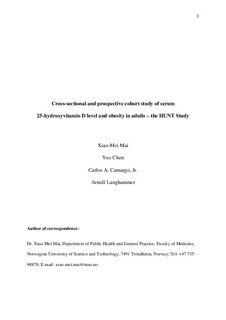Cross-Sectional and Prospective Cohort Study of Serum 25-Hydroxyvitamin D Level and Obesity in Adults
Journal article, Peer reviewed
Accepted version
Permanent lenke
http://hdl.handle.net/11250/2445685Utgivelsesdato
2012Metadata
Vis full innførselSamlinger
Sammendrag
Experimental studies suggest that vitamin D modulates the activity of adipocytes. The authors examined baseline serum 25-hydroxyvitamin D (25(OH)D) level in relation to prevalent and cumulative incident obesity in Norway. A cohort of 25,616 adults aged 19–55 years participated in both the second and third surveys of the Nord-Trøndelag Health Study (HUNT 2 (1995–1997) and HUNT 3 (2006–2008)). Serum 25(OH)D levels measured at baseline and anthropometric measurements taken at both baseline and follow-up were available for a random sample of 2,460 subjects. Overall, 40% of the 2,460 subjects had a serum 25(OH)D level less than 50.0 nmol/L, and 37% had a level of 50.0–74.9 nmol/L. The prevalence and cumulative incidence of obesity, defined as body mass index (weight (kg)/height (m)2) ≥30, were 12% and 15%, respectively. Lower serum 25(OH)D level was associated with a higher prevalence of obesity. In the 2,165 subjects with baseline BMI less than 30, a serum 25(OH)D level less than 50.0 nmol/L was associated with a significantly increased odds ratio for incident obesity during follow-up (adjusted odds ratio = 1.73, 95% confidence interval: 1.24, 2.41). When prevalent and incident obesity were classified according to waist circumference (≥88 cm for women, ≥102 cm for men), similar results were obtained. In addition to prevalent obesity, a serum 25(OH)D level less than 50.0 nmol/L was significantly associated with new-onset obesity in adults.
